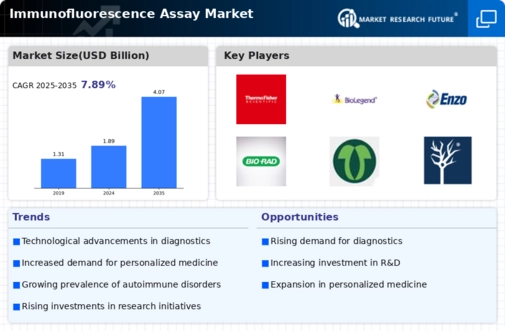Market Growth Projections
The Global Immunofluorescence Assay Market Industry is poised for substantial growth, with projections indicating an increase from 1.89 USD Billion in 2024 to 4.07 USD Billion by 2035. This trajectory reflects a compound annual growth rate of 7.22% from 2025 to 2035, highlighting the increasing reliance on immunofluorescence assays in various applications. The market dynamics are influenced by factors such as technological advancements, rising chronic disease prevalence, and the growing emphasis on personalized medicine. These elements collectively contribute to a robust growth outlook for the industry, suggesting a promising future for immunofluorescence assays.
Rising Prevalence of Chronic Diseases
The increasing incidence of chronic diseases globally drives the demand for advanced diagnostic tools, including immunofluorescence assays. As healthcare systems strive to improve patient outcomes, the Global Immunofluorescence Assay Market Industry is witnessing a surge in adoption. For instance, chronic conditions such as cancer and autoimmune diseases necessitate precise diagnostic methods. This trend is reflected in the projected market growth from 1.89 USD Billion in 2024 to an estimated 4.07 USD Billion by 2035, indicating a robust CAGR of 7.22% from 2025 to 2035. Such growth underscores the critical role of immunofluorescence assays in modern diagnostics.
Growing Demand for Personalized Medicine
The shift towards personalized medicine is reshaping the landscape of diagnostics, with immunofluorescence assays playing a pivotal role. The Global Immunofluorescence Assay Market Industry is experiencing heightened demand as healthcare providers seek tailored treatment approaches based on individual patient profiles. This trend is particularly evident in oncology and immunology, where precise biomarker identification is crucial. As the market evolves, the emphasis on personalized diagnostics is likely to drive further innovation and adoption of immunofluorescence assays, contributing to the anticipated growth from 1.89 USD Billion in 2024 to 4.07 USD Billion by 2035.
Regulatory Support and Funding Initiatives
Regulatory bodies and government initiatives are increasingly supporting the development and commercialization of immunofluorescence assays, thereby influencing the Global Immunofluorescence Assay Market Industry. Funding programs aimed at advancing diagnostic technologies are becoming more prevalent, encouraging innovation and research. This support not only facilitates the introduction of novel assays but also enhances the overall quality and reliability of existing products. As regulatory frameworks evolve to accommodate new technologies, the market is likely to benefit from increased investment and collaboration between public and private sectors, fostering a conducive environment for growth.
Increasing Research and Development Activities
The surge in research and development activities across various fields, including biotechnology and pharmaceuticals, is a key driver for the Global Immunofluorescence Assay Market Industry. As researchers seek to explore complex biological processes, the demand for reliable and efficient assay techniques rises. Immunofluorescence assays are integral to these research endeavors, facilitating the visualization of cellular components and interactions. The ongoing investment in R&D is expected to bolster the market, with projections indicating a growth trajectory that aligns with the broader trends in scientific exploration and innovation. This dynamic environment fosters a continuous need for advanced diagnostic tools.
Technological Advancements in Assay Techniques
Innovations in immunofluorescence assay technologies are significantly enhancing their accuracy and efficiency, thereby propelling the Global Immunofluorescence Assay Market Industry. Developments such as multiplexing capabilities allow simultaneous detection of multiple targets, which is particularly beneficial in research and clinical settings. These advancements not only improve diagnostic precision but also reduce time and resource consumption. As laboratories increasingly adopt these cutting-edge technologies, the market is expected to expand, aligning with the overall growth trajectory projected for the industry. The integration of automation and artificial intelligence in assay processes further indicates a transformative phase for immunofluorescence assays.



















Leave a Comment